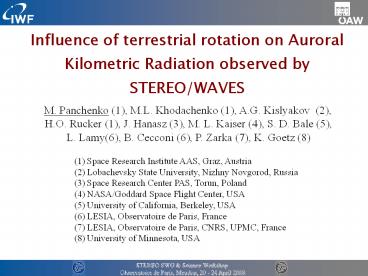STEREO SWG PowerPoint PPT Presentation
Title: STEREO SWG
1
Influence of terrestrial rotation on Auroral
Kilometric Radiation observed by STEREO/WAVES
M. Panchenko (1), M.L. Khodachenko (1),
A.G. Kislyakov (2), H.O. Rucker (1), J. Hanasz
(3), M. L. Kaiser (4), S. D. Bale (5), L.
Lamy(6), B. Cecconi (6), P. Zarka (7), K. Goetz
(8)
(1) Space Research Institute AAS, Graz,
Austria (2) Lobachevsky State University, Nizhny
Novgorod, Russia (3) Space Research Center PAS,
Torun, Poland (4) NASA/Goddard Space Flight
Center, USA (5) University of California,
Berkeley, USA (6) LESIA, Observatoire de Paris,
France (7) LESIA, Observatoire de Paris, CNRS,
UPMC, France (8) University of Minnesota, USA
2
- Auroral Kilometric Radiation (AKR) is a strongly
variable emission generated in the Earth's
magnetosphere - emitted near the local gyro-frequency of
electrons in low density source cavities, which
are identified with acceleration regions
characterized by upward directed parallel
electric fields - frequency range 20 kHz -1000kHz (300 kHz -gt l
1 km) - generation mechanism - Cyclotron Maser
Instability
3
Quasi-periodic variations of the AKR
- The AKR is a strongly variable radio emission
generated near the local gyro-frequency of
electrons in low density auroral cavities
frequency range 20 kHz -1000 kHz.
- Long quasi-periodic variations of the AKR
- Seasonal and solar cycle related variations of
AKR intensity, its occurrence and frequency range
(Kumamoto and Oya, 1998 Green et al., 2004). AKR
has a higher intensity, a broader frequency
range, and occurs more often in the winter polar
regions as well as during the maximum of the
solar cycle.
- Daily variation of the AKR
- Nodding of AKR radiation pattern relative a fixed
remote observer may cause a daily variation of
the AKR occurrence frequency (Kaiser et al.,
1978) - 24 h and 12 h modulation in AKR spectra measured
by Cassini/ RPWS during the Earth fly-by on
August 1999
4
STEREO Behind orbit
- STEREO, Solar TErrestrial RElations Observatory
consists of two (STEREO A and B) spacecraft,
launched on Oct. 25, 2006. - STEREO/WAVES (SWAVES) experiment
- high frequency receiver HFR1 (0.125 - 2 MHz)
measures spectral and cross-spectral power
densities determination of the radio wave
polarization. - 1.02.20071.05.2007 (DOY 32-122)
quasi-continuous observations of AKR.
5
AKR observations
6
AKR observations
7
Observations and data analysis
- Poynting flux and Stokes parameters of the
analyzed AKR were derived from the same
direction-finding algorithm (for two antenna
mode) as developed for the Cassini/RPWS
instrument Cecconi and Zarka, 2005.
- LH polarized wave AKR from Northern sources RH
polarized - Southern sources.
- AKR time profile has been produced by integration
of the AKR intensities, over frequency ranges
from 125 to 700 kHz.
- Sliding-window Fourier (SWF) transform
consists in application of the classical Fourier
transform within a certain interval of time (so
called "window") and in consequent shift of this
"window" along the time axis.
8
SWF dynamical spectra of the AKR modulations
Spectral peak at 23.9 /- 0.2 h
Spectral peak at 24.6 /- 0.2 h
SWF dynamical spectra of modulations (a, c) and
intensity profiles (panels b, d) of AKR emitted
by Northern and Southern sources. (e) and (f)
show the time averaged profiles of the SWF
dynamical spectra.
9
AKR source f700 kHz 21 h MLT 70 deg. invLat
10
STEREO-B trajectory in SM coordinates
23 Jan. 2007
18 Feb. 2007
11
AKR occurrence frequency
Normalized occurrence frequency and frequency
range of the AKR emitted from the Northern
hemispheres as functions of local time of the
axis of the magnetic dipole.
12
AKR spectra changes as a function of the
terrestrial dipole orientation relative to the
Sun (Green et al. 2004) Electron Cyclotron
Maser works most efficient within auroral
cavities, where fp/fc lt 0.14 (Hilgers, 1992)
During summer the local plasma frequency in
auroral region increases due to higher Sun
illumination of the ionosphere.
Green, J. L., S. Boardsen, L. Garcia, S. F. Fung,
and B. W. Reinisch (2004), Seasonal and solar
cycle dynamics of the auroral kilometric
radiation source region, J. Geophys. Res., 109,
A05223, doi10.1029/ 2003JA010311
13
Schematic view of the AKR source region.
angle g a - b characterizes the tilt of the
magnetic dipole relative the Sun.
The daily rotation of the tilted terrestrial
dipole and resulting diurnal change of its tilt
with respect to the Sun, may cause daily
modulations of plasma density along the auroral
field lines. This may cause diurnal modulation of
the AKR activity, analogous to the seasonal
variations.
14
AKR occurrence frequency
Normalized occurrence frequency and frequency
range of the AKR emitted from the Northern and
Southern hemispheres as functions of the
inclination angle g a - b (top panels) and
local time of the axis of the magnetic dipole
(bottom panels).
15
(No Transcript)
16
Conclusions
- Daily variations of terrestrial Auroral
Kilometric Radiation (AKR) are considered. The
effect is detected in course of the analysis of
STEREO/WAVES data. - It has been found that the intensities of the AKR
emitted from Northern and Southern sources are
strongly modulated with a period of 24 hours. - The occurrence frequency of the AKR has been
shown to be strongly dependent on the orientation
of the rotating oblique Earth's magnetic dipole
relative to the Sun. AKR is found to occur more
often and emit in a broader frequency range when
the axis of the terrestrial magnetic dipole in
the given hemisphere is oriented toward the
nightside. - We suggest that the observed 24 h variations of
AKR are connected with the daily modulation of
the local plasma density within the AKR source,
caused by the varying solar illumination of the
auroral ionosphere.

